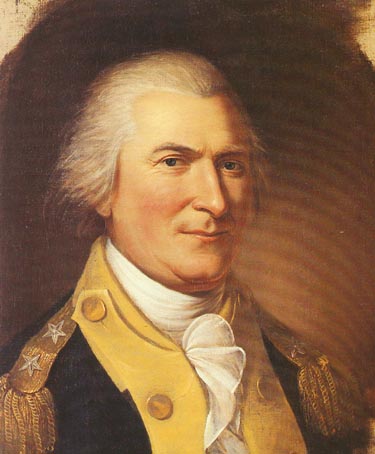By Charles Willson Peale
Oil on canvas, 22
Arthur St. Clair was born in Thurso, Caithness County, Scotland, on 23 March 1736 (old style); attended the University of Edinburgh briefly and later studied medicine under Dr. John Hunter in London; purchased a commission as ensign in Britain’s 60th Royal American Regiment and served in Canada under Generals Jeffrey Amherst and James Wolfe, 1757–1759; married Phoebe Bayard of Boston, 1760; resigned his British commission, 1762, and purchased an estate in the Ligonier Valley of Pennsylvania, 1764; commanded Fort Ligonier, 1767–1769; was appointed surveyor of the Cumberland District, 1770; was designated by Governor William Penn as agent of colonial government in his region, 1771; was a justice of Westmoreland County court; served as secretary to a congressional committee at the Treaty of Pittsburgh, 1775; was commissioned colonel in the Pennsylvania militia, 1775, and in the Continental Army, 1776, commanded the 2d Pennsylvania Battalion in abortive operations in Canada; was appointed brigadier general, 1776, and served with Washington’s forces in the battles of Trenton and Princeton, 1776–1777; was promoted to major general, 1777; was assigned to command of Fort Ticonderoga in June and abandoned it in July to a British investing force; was court-martialed and exonerated of blame for failing to hold the post, 1778; was present at the battle of Yorktown and served briefly with General Nathanael Greene in the South; left military service in 1783; was a Pennsylvania delegate to the Continental Congress, 1785–1787, and president of the Congress in 1787; was governor of the Northwest Territory 1787–1802, and administrator of Indian affairs there; was the senior officer of the United States Army, 4 March 1791–5 March 1792; led an expedition into Indian country and was disastrously defeated on the Wabash River, November 1791; resigned his commission in April 1792 and resumed the territorial governorship; was exonerated in a congressional inquiry from blame for the expedition’s failure; was removed, for political reasons, as territorial governor by President Jefferson, 1802; died at his Ligonier Valley home on 31 August 1818.
The Artist
Charles Willson Peale (1741–1827) gained his initial experience in portraiture by using members of his family as subjects. As his talents expanded he visited and developed patronage in New England, Maryland, and Virginia, as well as in London, England, finally settling in Philadelphia on the eve of active military service and the creation of his officer portrait gallery. By the close of the century, in addition to his numerous portraits of George Washington, he had painted many of the distinguished figures of the young nation, among them Arthur St. Clair at a moment when the general was completing his first military service in the Revolutionary War. The portrait is reproduced from the Independence National Historical Park Collection.
Arthur St. Clair
By Charles Willson Peale
Oil on canvas, 22![]() "
x 19
"
x 19![]() ", ca.
1782
", ca.
1782
[56]

[57]
page updated 30 April 2001